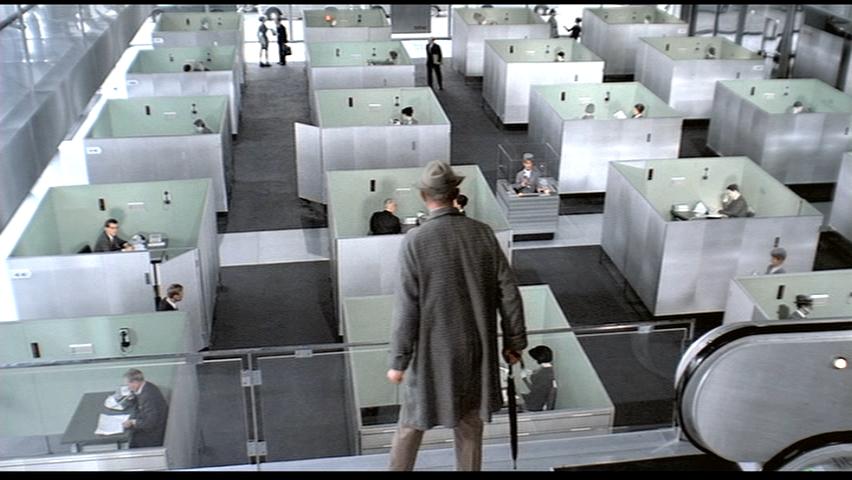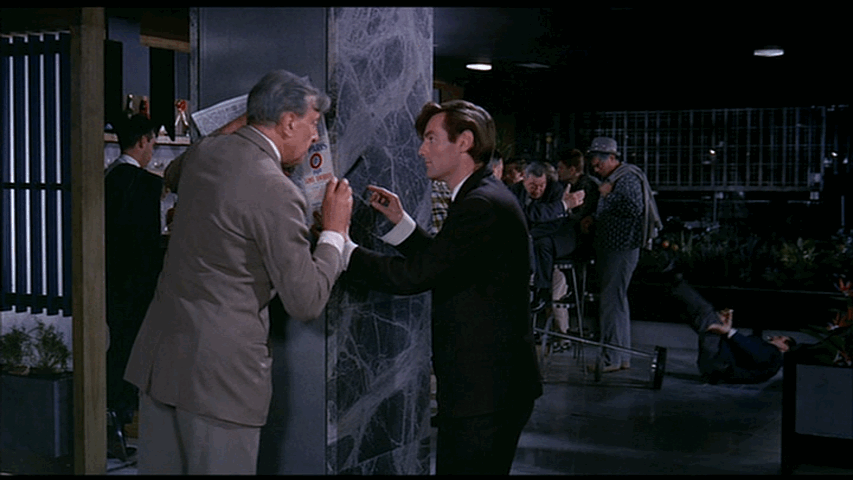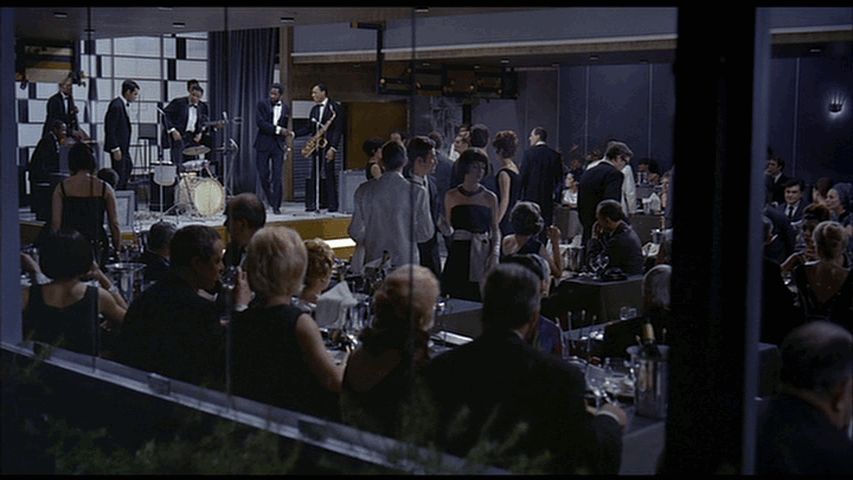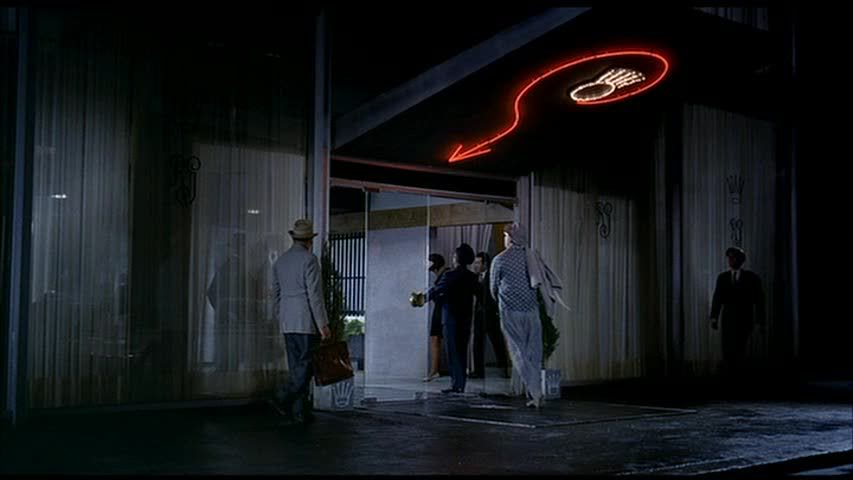This appeared in the Autumn 1976 Sight and Sound, and I hope I can be excused for omitting the article that occasioned it, Lucy Fischer’s “’Beyond Freedom and Dignity’: an analysis of Jacques Tati’s Playtime,” that was included in the same issue. (In her subsequent book-length bibliography of writings about Tati, Fischer omitted this Afterword, along with much else, so I guess that this exhumation of my Afterword without her article could be interpreted as some form of tit fortat. But in fact, I don’t have the rights to her piece, which I don’t believe has ever been reprinted. However, even though I fully realize that most college students prefer to ignore texts that they can’t find on the Internet, this is a piece well worth looking up in a well-stocked library.)
Beginning with a quote from an article by B.K. Skinner entitled “Beyond Freedom and Dignity” -– “We attempt to gain credit for ourselves by disguising or concealing control” –- Fischer’s article sets about attempting to refute my claims that Playtime was a fulfillment of Andre Bazin’s claim that the “long-take style” accorded more freedom to the viewer by showing how Tati’s own style guides the viewer in various ways and towards certain details through his uses of color, camera movement, and sound. Fischer concludes, ‘To some extent, in entering the world of a Tati film we encounter the ‘democracy’ of style that critics like Jonathan Rosenbaum have acclaimed. But we should not be surprised to discover at the helm of that purported democratic ship of state a marvelously benevolent despot.”
Even though Lucy’s article disagrees with my basic thesis about the film (and even though I consider “marvelously benevolent despot” an oxymoron), I made a strong case to Penelope Houston (my boss at the time) that she should publish it, especially considering how little of any substance had been published about Tati’s masterpiece at the time, and, if memory serves, it was Penelope who suggested that I draft a response to it. Later, when I met Lucy, I foolishly gave her my only copy of an excellent text by Jean-Andre Fieschi about Tati in La Nouvelle Critique that she never even bothered to mention in her book-length Tati bibliography, much less return to me — a sign of indifference that was even more pronounced in her lousy book about Sunrise.-– J.R.
As a supplement to Lucy Fischer’s important article, I’d like to offer three points which seem worth noting in any comprehensive account of the film in relation to an audience’s real or imagined freedom.
(1) All the examples of ‘benevolent’ despotism cited above [by Fischer] — whether effected by color, sound or camera movements — are, it is true, designed to urge the spectator to ‘notice’ certain things. (One might add to this list the use of dummies and/or cut-out figures in addition to real extras in the backgrounds of certain shots.) But just as clearly, they are designed to divert the spectator from other things, some of which later develop into events or gags which take one entirely by surprise. During the later stages of the Royal Garden festivities, one gag at the bar is repeated twice: a drunk and the stool he is sitting on simultaneously crash to the floor when he leans back too far. What makes this event a great deal funnier the first and third time it happens is its unexpectedness; amidst a flurry of other focal points, Tati’s mise en scène has insured that we notice its occurrence only after we hear the crash, interrupting our attention elsewhere and immediately refocusing it. The third occurrence, for example, interrupts Hulot’s efforts in the foreground to give another drunk street directions — a detail which itself plays on confusions, as the young man’s fingers trace beyond a plan de Paris to the similarly patterned pillar he is holding it against. (As a play on the continuity and discontinuity of separate ‘signs’, this gag, like countless others, parodies our own organizational capacities while watching the film.)
Another example occurs much earlier at the Royal Garden, and although it is not a ‘gag’ in any ordinary sense, it has come to represent for me of the most beautiful moments in all of cinema: the instant that the first of the restaurant’s bands starts to play. How could such a fleeting detail seem so extraordinary? Because over repeated viewings of the film I have nearly always been unable to anticipate this instant even by a fraction of a second; each time, Tati’s complex strategies — which include his unobtrusive time abridgements — have contrived to prevent me from taking notice of the musicians’ assembly on the bandstand. In short, the film is predicated on one’s inattentiveness as much as one’s attentiveness, which in turn affects one’s sense of real or imagined freedom. After missing a detail, one naturally concludes that one could have chosen to see it, and tries to become more vigilant in anticipating future surprises, playing a sort of guessing-game that is ironically more fun to lose than to win.
(2) Between those areas on the screen which one is encouraged to ‘notice’ or ‘not notice’ are other areas where the emphasis is more unstable and shifting — a terrain perhaps best described by Noël Burch in Cahiers du Cinéma No. 199 as that of the ‘refused gag’, where a gag that has been ‘started in one sequence, completed in another, developed in a third and repeated in a fourth’ can be ‘refused in a fifth. This teasing ‘promise’ of a gag that is never quite delivered comes in many forms (a random example: the street worker’s slabs of cement which almost splatter a well-dressed lady pedestrian), and is a crucial part of Tati’s tactics, whereby the mere possibility or preparation of a gag alters the overall dynamics of the image and soundtrack.
(3) Repeated viewings have a very special bearing on the extent of a spectator’s ‘real’ freedom in relation to Playtime. Although the falling drunk on the bar-stool has made my own ‘controlled’ inattention the virtual subject of a gag in Tati’s terms, the gag has never been experienced twice in the same way because the degrees of relative attention and awareness have fluctuated with each viewing. However firm Tati’s guidelines may be in ‘directing’ attention, one nevertheless acquires increasing freedom in how much one willingly submits to this pressure as one increases one’s familiarity with the film.
Indeed, a paradoxical aspect of Playtime‘s fascination is that it yields up its greatest treasures only after one becomes aware of its brilliantly deceptive manipulations and begins to chart one’s own mise en scène in relation to Tati’s — a collaborative act that combines the rigorous work of a land-surveyor with the improvisational play of a tourist. (A central function to the film’s use of music is to provide a rhythmical ‘anchor’ and guideline to the spectator in plotting out his or her movements in this activity; it enables one to experience the process of observation itself as a kind of spontaneous, joyous and continuous dance.) Even here, it goes without saying that one’s freedom operates within well-defined constraints: the fact that Tati’s mise en scène remains necessarily stronger than one’s own. All existing democracies, one might add, exhibit comparable ambiguities about freedom. But if one familiarises oneself with the powers that be — a step few citizens seem willing to take — one can participate in the decision-making process with open eyes, receptive ears and an active mind. Within these conditions, Tati functions rather less as a ‘benevolent despot’ and somewhat more as a duly elected official.








